Rurrenabaque
by A. Bennett Hennessey

With limited time, a good strategy is to bird the
airport runway and trails. Spectacular secondary forest birds here
include: Yellow-headed Caracara, Crane Hawk, Speckled Chachalaca, Squirrel
Cuckoo, Grey-breasted Sabrewing, Yellow-tufted Woodpecker, Magpie Tanager,
Musician Wren, Russet-backed Oropendola and Yellow-rumped Cacique. The
airport edges offer a good example of secondary forest, with occasionally
Yellowish Pipit, Southern Lapwing and Seedeaters along the runway
strip. As you arrive, ask the airport operators if you may walk along
the runway. In the past this has not been a problem. The runway
is shaped like a cross. At the main reception building, walk directly
across the runway to a small building on the other side. Here there is
a very well used trail, which will eventually loop around to the opposite
side of runway, allowing one to return to the reception area along the runway
itself.

Rurrenabaque is
right on the edge of the Beni River(Have great fish at the restaurant Perla de Rurre). If you are unable to leave town, or
only have a few hours, walking along the river edge will yield birds such as
Spotted Sandpiper, Rufous Hornero, Guira Cuckoo, and Silver-beaked
Tanager. Following the river upstream (south) will eventually lead into
a disturbed forest habitat with less sensitive forest birds such as
Blue-crowned Motmot, Chestnut-tailed Antbird, Purple-throated Euphonia
(listen through-out the town for its peep-peep call), Short-crested
Flycatcher and Epaulet Oriole. Along the river downstream (north) will
provide access to habitat with early successional plants and a thin forest
with Dusky-headed Parakeet, and Smooth-billed Ani. Good luck
determining whether the common sky-blue tanagers are Blue-grey or Sayaca
Tanagers; Ted Parker apparently thought that Rurrenabaque was a hybrid zone
for the two species. Also, try the central plaza at night for the
Tropical Screech-Owl named Herby, made famous on Sjoerd Mayer’s CD-ROM Birds
of Bolivia.
For the more adventurous,
there is plenty of good birding in the tropical forest north of
Rurrenabaque. Most of these areas are made accessible by single lane
local logging roads. These roads are constructed to extract a few
species of valuable trees (like mahogany) and then abandoned. Many of
these roads can be long and demand a few days of camping.
Unfortunately, good sites are constantly changing. The best bet would
be to rent a car or dirt bike in Rurrenabaque and start exploring. For
those on a tight budget, one can get a lift from passing trucks, jumping off
at a promising site (remember in
Bolivia
, these rides are not
free, you are expected to pay a few Bolivianos). Finally, the endangered Wattled Curassow Crax
globulosa is believed to still exist on the east side of the Beni river down river (north) from Rurrenabaque.
The locals say that it can still be found, especially in the dry season
around Estrella Lake(Lago Estrella), a trail leading east from the town of San Marcos
and the three oxbow lakes found North of San Marcos to the East of Beni River
(Wattled Curassow
Lodge).
Logistics: Leaving the
Rurrenabaque on the only road out of town, the airport is on the left after
the only large concrete bridge- you can see the runway to the left from the
road. The airport is before the road tax block and the junction with
the road to Reyes and the road to Yucumo and eventually La Paz.
A local motorbike taxi (moto taxis in Spanish) can drop you there for
6 Bolivianos and then pick you up later if you are specific about the terms,
times and withhold final payment. If there is a flight later in the
day, there will be a bus and many moto taxis to take you back into town. |

